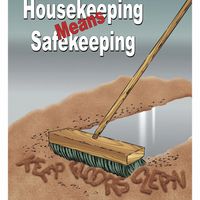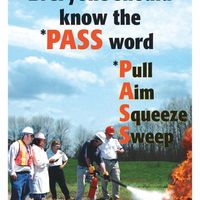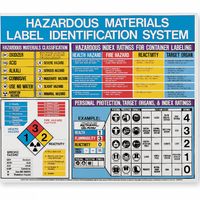Call +(254) 703 030 000 / 751 483 999 / 721 704 777
- Home
- Safety
- Signs Facility Identification Products
- Safety Facility Banners Posters Mirrors
- Safety Facility Posters
.....Read More
Frequently Asked Questions
What are the key elements of an effective safety poster?
An effective safety poster should include the following key elements:
1. **Clear Message**: The poster should convey a straightforward and concise message. Use simple language and focus on one main idea to avoid confusion.
2. **Eye-catching Design**: Utilize bold colors, large fonts, and engaging graphics to capture attention. The design should be visually appealing but not overwhelming.
3. **Relevant Imagery**: Incorporate images or icons that are directly related to the safety message. Visuals should be easily recognizable and support the text.
4. **Readable Text**: Ensure that the text is legible from a distance. Use a font size and style that is easy to read, and maintain a good contrast between text and background.
5. **Call to Action**: Include a clear call to action that tells viewers what they should do to stay safe. This could be a directive like "Wear Safety Goggles" or "Report Hazards Immediately."
6. **Consistency**: Align the poster with the overall safety branding of the organization. Consistent use of colors, logos, and messaging reinforces the safety culture.
7. **Location-Specific Information**: Tailor the content to the specific environment or audience. Include information that is relevant to the particular risks and safety protocols of the area.
8. **Contact Information**: Provide details on who to contact for more information or in case of an emergency. This could include a phone number or a department name.
9. **Engagement**: Encourage interaction by posing questions or including a QR code that links to additional resources or training materials.
10. **Regular Updates**: Keep the content current and relevant. Update the poster as safety protocols or regulations change to ensure ongoing effectiveness.
Where should safety posters be placed in a facility?
Safety posters should be strategically placed in areas where they are most likely to be seen and can have the greatest impact. Key locations include:
1. **Entrances and Exits**: Placing posters at entry and exit points ensures that employees and visitors see them as they come and go, reinforcing safety messages.
2. **Common Areas**: High-traffic areas such as break rooms, cafeterias, and restrooms are ideal for safety posters, as they are frequented by employees throughout the day.
3. **Near Equipment and Machinery**: Posters should be placed near machinery and equipment to remind workers of specific safety protocols and the proper use of equipment.
4. **Workstations**: Positioning posters at individual workstations can provide immediate reminders of safety procedures relevant to specific tasks.
5. **Hallways and Corridors**: These are good locations for general safety reminders, as they are often used by employees moving between different areas of the facility.
6. **Emergency Exits and Equipment**: Posters near emergency exits, fire extinguishers, and first aid kits can provide critical information during emergencies.
7. **Training and Meeting Rooms**: Displaying safety posters in these rooms can reinforce messages during training sessions and meetings.
8. **Construction or Renovation Areas**: Temporary safety posters should be placed in areas undergoing construction or renovation to alert workers and visitors to potential hazards.
9. **Loading Docks and Warehouses**: These areas often involve heavy equipment and vehicle traffic, making them critical spots for safety reminders.
10. **Stairwells and Elevators**: These locations can be used to remind employees of safe practices related to movement within the facility.
By placing safety posters in these strategic locations, facilities can effectively communicate safety messages and promote a culture of safety awareness among employees and visitors.
How often should safety posters be updated or changed?
Safety posters should be updated or changed whenever there are changes in regulations, procedures, or equipment that affect safety protocols. Regular reviews should occur at least annually to ensure information remains current and relevant. Additionally, updates should be made immediately following any incident or near-miss that reveals gaps in safety communication. It's also beneficial to refresh posters periodically to maintain employee engagement and prevent complacency, ideally every 1-2 years.
What are the legal requirements for safety posters in the workplace?
Legal requirements for safety posters in the workplace vary by country, but generally include the following key elements:
1. **Mandatory Postings**: Employers are often required to display specific safety posters mandated by government agencies. In the U.S., for example, the Occupational Safety and Health Administration (OSHA) requires the "OSHA Job Safety and Health: It's the Law" poster to be displayed in a conspicuous location.
2. **Language and Accessibility**: Safety posters must be accessible to all employees, which may require translations into languages spoken by the workforce. They should be placed at eye level and in areas where employees frequently gather, such as break rooms or near time clocks.
3. **Content Requirements**: Posters must include information on workers' rights, safety procedures, emergency contacts, and reporting mechanisms for unsafe conditions. They should be clear, concise, and use easily understandable language and visuals.
4. **Industry-Specific Requirements**: Certain industries may have additional requirements. For instance, construction sites might need specific hazard communication posters, while healthcare facilities may require infection control information.
5. **Regular Updates**: Employers must ensure that safety posters are up-to-date with the latest legal and safety information. This includes updating posters when laws change or when new safety protocols are introduced.
6. **Supplementary Information**: While not always legally required, employers are encouraged to display additional safety information relevant to their specific workplace hazards, such as fire evacuation routes or equipment operation guidelines.
7. **Penalties for Non-Compliance**: Failure to comply with posting requirements can result in fines and penalties from regulatory bodies. Regular audits and inspections may be conducted to ensure compliance.
Employers should consult local regulations and legal counsel to ensure full compliance with all applicable safety poster requirements.
How can safety posters be used to improve workplace safety culture?
Safety posters can significantly enhance workplace safety culture by serving as constant visual reminders of safety protocols and best practices. They reinforce the importance of safety, making it a priority in daily operations. By strategically placing posters in high-traffic areas, they ensure that safety messages are consistently visible to all employees, promoting awareness and mindfulness.
These posters can also serve as educational tools, providing clear, concise instructions on how to handle equipment, respond to emergencies, or perform tasks safely. This helps in reducing accidents and injuries by ensuring that employees are well-informed about potential hazards and the correct procedures to mitigate them.
Moreover, safety posters can be tailored to address specific risks associated with different work environments, making them relevant and effective. They can also be used to communicate updates in safety regulations or changes in procedures, ensuring that all employees are up-to-date with the latest safety information.
In addition to providing information, safety posters can motivate employees by highlighting the benefits of a safe workplace, such as reduced injury rates and improved productivity. They can also recognize and celebrate safety achievements, fostering a sense of pride and ownership among employees.
By incorporating engaging visuals and clear messaging, safety posters can capture attention and facilitate better retention of safety information. This contributes to creating a safety-conscious culture where employees are more likely to adhere to safety practices and encourage their peers to do the same.
Overall, safety posters are an effective tool for embedding safety into the workplace culture, promoting a proactive approach to safety, and ultimately contributing to a safer work environment.
What types of information should be included on fire and emergency posters?
1. **Emergency Contact Information**: Include phone numbers for fire department, police, and medical services.
2. **Evacuation Routes**: Clearly marked maps showing primary and secondary escape routes.
3. **Assembly Points**: Designated safe areas where people should gather after evacuation.
4. **Fire Alarm Locations**: Indicate where fire alarms are located and how to activate them.
5. **Fire Extinguisher Locations**: Show where fire extinguishers are placed and provide basic instructions on their use.
6. **Emergency Procedures**: Step-by-step actions to take in case of fire or other emergencies.
7. **First Aid Kit Locations**: Indicate where first aid kits are available.
8. **Emergency Exits**: Clearly marked exits with instructions on how to open them.
9. **Do’s and Don’ts**: Quick tips on what to do and avoid during an emergency (e.g., don’t use elevators).
10. **Smoke and Fire Safety Tips**: Information on how to stay low in smoke, stop-drop-roll technique, etc.
11. **Emergency Lighting**: Indicate the presence of emergency lighting and its importance.
12. **Special Instructions for Disabled Individuals**: Procedures for assisting those with disabilities.
13. **Emergency Shutdown Procedures**: Instructions for shutting down critical equipment safely.
14. **Language and Symbols**: Use universally understood symbols and multiple languages if necessary.
15. **Date of Last Update**: Ensure information is current by including the last update date.
16. **QR Codes or Links**: For more detailed information or training videos.
17. **Contact for More Information**: A person or department to contact for further details or training.
How can facility posters be used to communicate non-safety related protocols effectively?
Facility posters can effectively communicate non-safety related protocols by utilizing strategic design and placement to capture attention and convey information clearly. First, they should employ visually appealing graphics and colors that align with the facility's branding to ensure consistency and recognition. The use of icons and symbols can help in quickly conveying messages, especially in diverse environments with language barriers.
Content should be concise and focused, using bullet points or numbered lists to enhance readability. Key information should be highlighted using bold fonts or contrasting colors to draw attention. Including a QR code can provide an easy way for individuals to access more detailed information online, catering to those who seek further understanding.
Placement is crucial; posters should be located in high-traffic areas such as entrances, break rooms, and common areas where they are most likely to be seen. Rotating the posters periodically can prevent them from becoming part of the background and losing effectiveness.
Incorporating feedback mechanisms, such as a suggestion box or a contact email, can engage employees and encourage interaction with the content. This also allows for continuous improvement of communication strategies.
Finally, aligning the posters with other communication channels, such as emails or meetings, can reinforce the message and ensure comprehensive understanding. By integrating these elements, facility posters can serve as an effective tool for communicating non-safety related protocols, ensuring that all individuals within the facility are informed and engaged.


